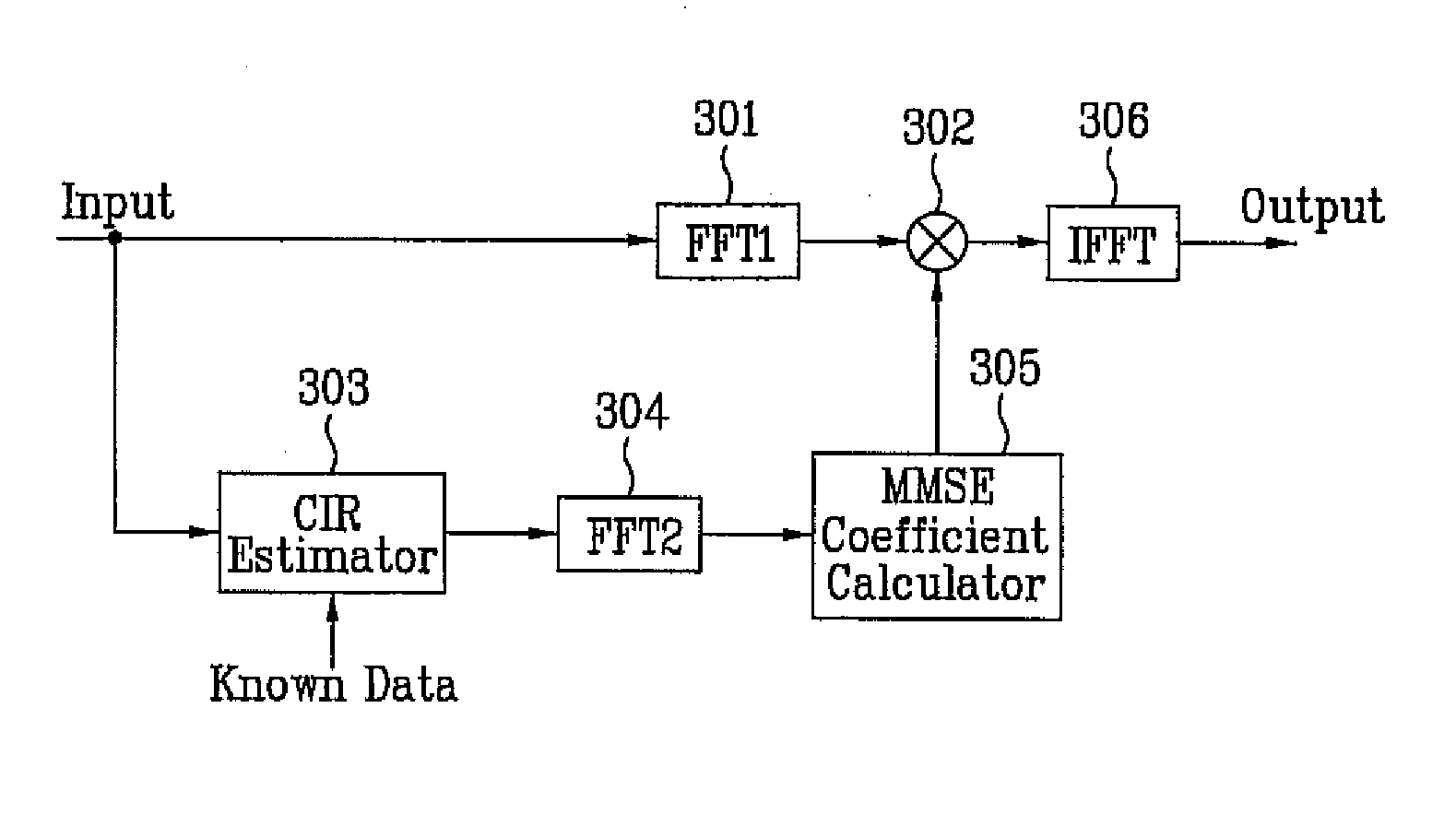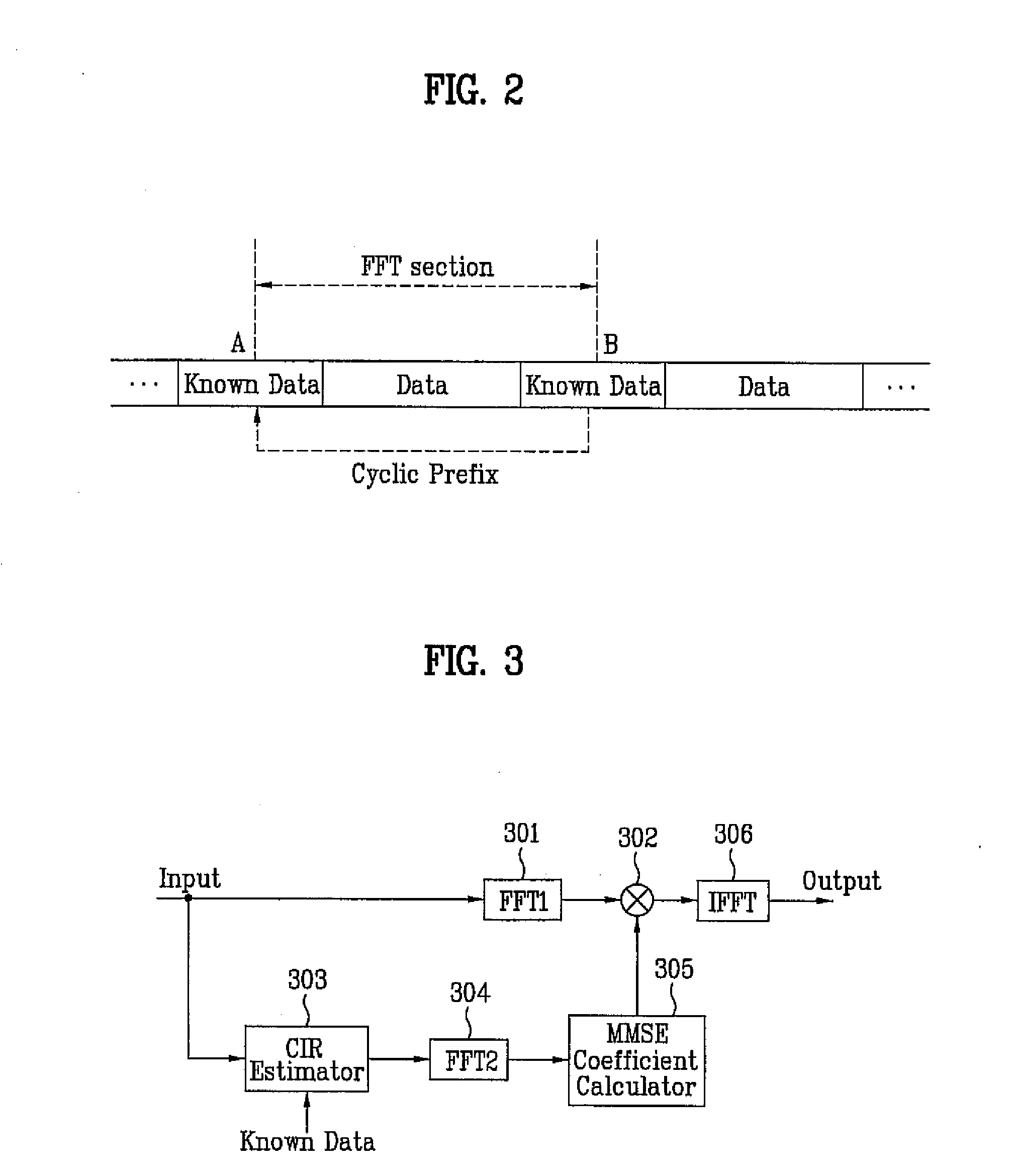Channel equalizer and method of processing broadcast signal in DTV receiving system
a channel equalizer and broadcast signal technology, applied in the field of digital telecommunications systems, can solve the problems of data transmission that is to be transmitted, data quality that is to be deteriorated, and the intensity of signals may decrease, so as to compensate channel distortion
- Summary
- Abstract
- Description
- Claims
- Application Information
AI Technical Summary
Benefits of technology
Problems solved by technology
Method used
Image
Examples
first embodiment
[0041]FIG. 3 illustrates a block diagram of a channel equalizer according to the present invention. More specifically, FIG. 3 illustrates a block diagram of a frequency domain channel equalizer using an indirect equalization method according to the present invention. Referring to FIG. 3, the channel equalizer includes a first fast fourier transform (FFT) unit FFT1301, a distortion compensator 302, a channel estimator 303, a second FFT unit FFT2304, a MMSE coefficient calculator 305, and an inverse fast fourier transform (IFFT) unit 306. Herein, any device performing complex number multiplication may be used as the distortion compensator 302.
[0042] In the channel equalizer having the above-described structure, as shown in FIG. 3, the first FFT unit 301 performs a FFT process on the received data so as to convert the data to frequency domain data. The frequency domain data are then outputted to the distortion compensator 302. At this point, if known data sequences having the same patt...
second embodiment
[0046] In order to resolve such problems, another example of a channel equalizer is presented in FIG. 4. FIG. 4 illustrates a block diagram of a channel equalizer of the frequency domain according to the present invention. Herein, an average value of the CIRs is used for channel equalizing the general data. More specifically, when performing the equalization process, an average value of the CIR of point A and the CIR of point B is used to perform a channel equalization process on the general data section between point A and point B, thereby enhancing the equalization performance. Accordingly, the channel equalizer shown in FIG. 4 further includes an average calculator 307 between the channel estimator 303 and the second FFT unit 304 of FIG. 3.
[0047] More specifically, the channel estimator 303 estimates the CIR by using the data received during the known data section and the known data. Then, the estimated CIR is outputted to the average calculator 307. Herein, the average calculato...
fifth embodiment
[0062]FIG. 10 illustrates a block diagram of a channel equalizer according to the present invention. More specifically, FIG. 10 illustrates a block diagram showing the structure of a channel equalizer of a frequency domain using a direct equalization method according to the present invention. Referring to FIG. 10, the channel equalizer includes an overlap unit 501, a first fast fourier transform (FFT) unit 502, a distortion compensator 503, an inverse fast fourier transform (IFFT) unit 504, a save unit 505, a decision unit 506, a select unit 507, a subtractor 508, a zero padding unit 509, a second FFT unit 510, a coefficient update unit 511, and a delay unit 512. Herein, any device that performs complex number multiplication may be used as the distortion compensator 503.
[0063] In the channel equalizer having the above-described structure, as shown in FIG. 10, the received data are overlapped by the overlap unit 501 and are outputted to the first FFT unit 502. The first FFT unit 502 ...
PUM
 Login to View More
Login to View More Abstract
Description
Claims
Application Information
 Login to View More
Login to View More - R&D
- Intellectual Property
- Life Sciences
- Materials
- Tech Scout
- Unparalleled Data Quality
- Higher Quality Content
- 60% Fewer Hallucinations
Browse by: Latest US Patents, China's latest patents, Technical Efficacy Thesaurus, Application Domain, Technology Topic, Popular Technical Reports.
© 2025 PatSnap. All rights reserved.Legal|Privacy policy|Modern Slavery Act Transparency Statement|Sitemap|About US| Contact US: help@patsnap.com



